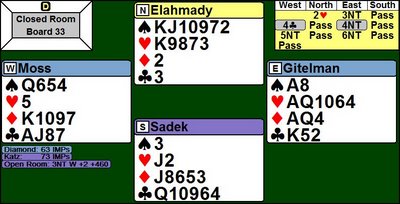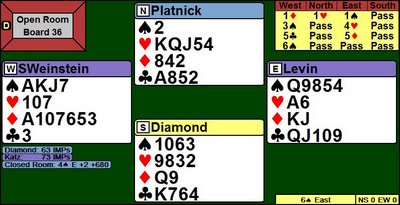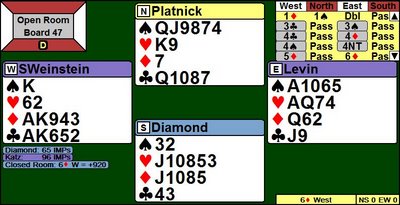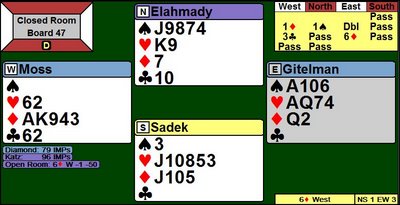Vandy Lite
The Katz team unveiled a new tactic for the Vanderbilt - a smaller team! As today's bulletin from Houston notes:
As Memphis Mojo reported before, this was not Steve Weinstein's first big final table of 09:
http://pokerandbridge.blogspot.com/2009/02/bridge-player-wins-borgata.html
Poker News Daily notes that the prize amount does not reflect a four-way "chop" that would have split the winnings in some way for the top four players:
http://www.pokernewsdaily.com/steve-weinstein-thorladen-victorious-in-borgata-winter-open-992/
The article quotes Steve Weinstein:
The third quarter of the Vandy final effectively decided this Saturday's final table.
On the first board of the second half, Elahmady opened 2H showing a weak hand with Hs & Other, and Gitelman-Moss drove to a very bad 6NT contract:

.
.
.
.
.
.
.
.
.
.
They might not have been on the same page regarding 4NT, as to whether it showed or denied extras for the 3NT bid. Gitelman did well to get out for -50, but lost 11 IMPs.
UPDATE: Please see Fred Gitelman's remarks in the comments.
Three boards later Levin-Weinstein would not fold their hands before they got to the vulnerable slam:

.
.
.
.
.
.
.
.
.
.
.
Over Levin's jump to 3S, Weinstein cuebid 4H, and they got to 6S. In the other room, Gitelman simply bid 4S over 3S, and there they stayed to lose 13 IMPs.
On the second last board of the quarter, both teams got to 6D:

.
.
.
In both rooms North led the spade queen, to declarer's king. Declarer played off the ace and king of clubs, and then ruffed a club with dummy's six, overruffed by South's eight, to leave this:

.
.
.
In this position, Sadek tried the diamond jack. Moss won the diamond ace, played a heart to the queen, ruffed a spade, heart to the ace, and now could crossruff successfully with the diamond ten onside. Once Sadek returned the high diamond, Moss's elegant trump coup was the necessary play to bring in the slam.
In the other room Diamond, South, kept his remaining diamonds. Instead he fired back a heart into dummy's AQ, and now declarer was down. The Diamond team had recovered 14 IMPs.
However that was the last swing over 2 IMPs for them in the match as the Katz team had an abundance of stamina, and played super tight the rest of the way.
In the semis, the Diamond team beat the #1 seed Nickell. The Diamond team had two pairs playing "Meckwell Lite", a simplified version of the Meckwell Big Club system. In each set that Meckwell played in, the Diamond team had a "Meckwell Lite" pair sitting at the other table in the same direction. In the second and third quarters the Diamond-Platnick partnership were the Meckwell clones.
As Gitelman noted at the start of the event, with great foreshadowing:
The second quarter was won by the Diamond team 71-26, and the third quarter 42-13.
I was not surprised to see a Friday comment on this blog (to an older post) asking for Meckwell Lite notes. These are not available on the net at this time, and generally it is up to Meckwell to decide when and how they will release items with their brand. However if you still want a big club system after watching three pairs playing little 2/1 win the Vandy, you can create your very own Lite system with these steps:
- Start with the system base in the Precision Today book (by David Berkowitz, winner of the Houston Open Pairs with Larry Cohen, and the terrific bridge editor/writer Brent Manley)
- Play 1NT as 14-16, except in 4th seat and 3rd seat vulnerable, when it is 15-17
- Play the 1C-1H response as any 8-11 - this is game forcing, and gives room for both players to fully describe their hands
- Play the 1C-1S/1NT/2C/2D/2H responses as natural with 12+. Now the partnership knows that slam may be in the picture
- Open all 11 counts
- Frequently upgrade based on playing value.
Once you put the system in place, don't waste much time tinkering with it - the key to using a Meckwell type system is declaring and defending like Meckwell. And of course if you want to be in Lite tournament shape, don't forget to go to the gym!
The Katz team unveiled a new tactic for the Vanderbilt - a smaller team! As today's bulletin from Houston notes:
... Sadek said he and his partner, both rather large men, had two reasons to thank Jacobs for inviting them to play. First was the chance to win, which they did. Second, the invitation gave them an incentive to get in better physical condition to be able to stand the rigors of the tough bridge competition. "We went to the gym for three months," Sadek said. "I lost 45 pounds and Walid lost 15. We thank George for the chance to win but also because we are now healthier."Now, will other sponsors exercise their teams to a win?
As Memphis Mojo reported before, this was not Steve Weinstein's first big final table of 09:
http://pokerandbridge.blogspot.com/2009/02/bridge-player-wins-borgata.html
Poker News Daily notes that the prize amount does not reflect a four-way "chop" that would have split the winnings in some way for the top four players:
http://www.pokernewsdaily.com/steve-weinstein-thorladen-victorious-in-borgata-winter-open-992/
The article quotes Steve Weinstein:
"The structure was tremendous. I'm not a tournament player; I play cash games, so to have a deep stack event like this with so much play was great. For someone who loves post-flop poker, it was excellent."What he means by all that, is that the format of the tournament avoided the endless "all-in" of quicker tournaments, and thus he could employ his top notch ability to read other players and calculate odds to make the best decisions. Thus Steve Weinstein won an event more like bridge: less gambling and more determining.
The third quarter of the Vandy final effectively decided this Saturday's final table.
On the first board of the second half, Elahmady opened 2H showing a weak hand with Hs & Other, and Gitelman-Moss drove to a very bad 6NT contract:
.
.
.
.
.
.
.
.
.
.
They might not have been on the same page regarding 4NT, as to whether it showed or denied extras for the 3NT bid. Gitelman did well to get out for -50, but lost 11 IMPs.
UPDATE: Please see Fred Gitelman's remarks in the comments.
Three boards later Levin-Weinstein would not fold their hands before they got to the vulnerable slam:
.
.
.
.
.
.
.
.
.
.
.
Over Levin's jump to 3S, Weinstein cuebid 4H, and they got to 6S. In the other room, Gitelman simply bid 4S over 3S, and there they stayed to lose 13 IMPs.
On the second last board of the quarter, both teams got to 6D:
.
.
.
In both rooms North led the spade queen, to declarer's king. Declarer played off the ace and king of clubs, and then ruffed a club with dummy's six, overruffed by South's eight, to leave this:
.
.
.
In this position, Sadek tried the diamond jack. Moss won the diamond ace, played a heart to the queen, ruffed a spade, heart to the ace, and now could crossruff successfully with the diamond ten onside. Once Sadek returned the high diamond, Moss's elegant trump coup was the necessary play to bring in the slam.
In the other room Diamond, South, kept his remaining diamonds. Instead he fired back a heart into dummy's AQ, and now declarer was down. The Diamond team had recovered 14 IMPs.
However that was the last swing over 2 IMPs for them in the match as the Katz team had an abundance of stamina, and played super tight the rest of the way.
In the semis, the Diamond team beat the #1 seed Nickell. The Diamond team had two pairs playing "Meckwell Lite", a simplified version of the Meckwell Big Club system. In each set that Meckwell played in, the Diamond team had a "Meckwell Lite" pair sitting at the other table in the same direction. In the second and third quarters the Diamond-Platnick partnership were the Meckwell clones.
As Gitelman noted at the start of the event, with great foreshadowing:
John Diamond and Brian Platnick, are quite likely the strongest "sponsor pair" in the event.( http://forums.bridgebase.com/index.php?showtopic=30860&st=0&#entry352670)
The second quarter was won by the Diamond team 71-26, and the third quarter 42-13.
I was not surprised to see a Friday comment on this blog (to an older post) asking for Meckwell Lite notes. These are not available on the net at this time, and generally it is up to Meckwell to decide when and how they will release items with their brand. However if you still want a big club system after watching three pairs playing little 2/1 win the Vandy, you can create your very own Lite system with these steps:
- Start with the system base in the Precision Today book (by David Berkowitz, winner of the Houston Open Pairs with Larry Cohen, and the terrific bridge editor/writer Brent Manley)
- Play 1NT as 14-16, except in 4th seat and 3rd seat vulnerable, when it is 15-17
- Play the 1C-1H response as any 8-11 - this is game forcing, and gives room for both players to fully describe their hands
- Play the 1C-1S/1NT/2C/2D/2H responses as natural with 12+. Now the partnership knows that slam may be in the picture
- Open all 11 counts
- Frequently upgrade based on playing value.
Once you put the system in place, don't waste much time tinkering with it - the key to using a Meckwell type system is declaring and defending like Meckwell. And of course if you want to be in Lite tournament shape, don't forget to go to the gym!

5 Comments:
At 4:51 AM, Glen Ashton said…
Glen Ashton said…
Gal posted a comment to correct my mistake on the Moss hand - however the comment is found for the previous posting but it applies here. Thanks Gal, I knew I missed something on the hand but could not find it, and I've now added an Edit to the end of that section to provide the correction.
At 4:55 AM, Glen Ashton said…
Glen Ashton said…
I've pulled the wrong text right out of the article, after posting an inline Update/Edit and later a strikeout of the text.
The policy of this blog will be to fix mistakes at any time with credit for the spotter in the comments.
At 11:48 AM, Fred Gitelman said…
Fred Gitelman said…
Hi Glen,
What went wrong on the 6NT hand was that both Brad and I were mildly aggressive on the same hand. Still, the contract almost made - it would not have been hard for me to win 12 tricks if RHO's singleton club was the Q, 10, or 9 or if LHO's singleton spade was the King.
My 3NT overcall was supposed to show a sound 2NT opening, but I thought there was a good tactical case for making this overbid - my hand was too good for 2NT and I thought any other approach was likely to allow LHO to learn what his partner's second suit was.
Brad also overbid slightly as he thought it was likely that I had some 4+ card suit other than hearts.
4NT did show a minimum balanced hand.
The hand we missed 6H, I took a giant position, but I did not expect Brad to have a hand like the one he held (I would have expected him to bid 4S). My main concern was that he held only 3 spades (we do not play support doubles in this auction).
I really enjoy reading your blog, but you should use the Handviewer program to produce your bridge diagrams :)
Regards,
Fred Gitelman
At 11:11 AM, Memphis MOJO said…
Memphis MOJO said…
Nice post. Both teams played just super bridge.
At 7:09 PM, Larry said…
Larry said…
Meckwell Lite: I think you should reverse 1C - 1H and play it 12+ and all other responses as 8-11. You have more room for slam potential hands and the higher frequency responses (8-11) start immediately to show their distribution.
Larry
Post a Comment
<< Home